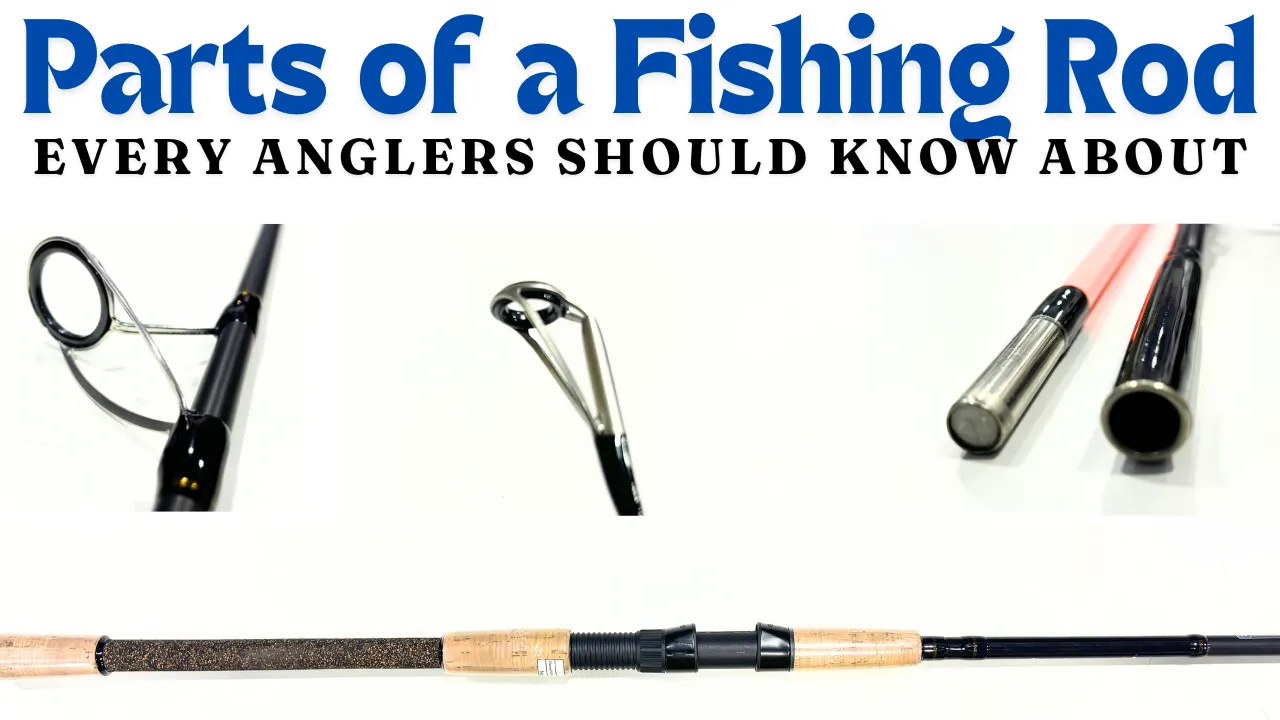1. Introduction
Fishing as an art of hunting is one of the oldest inventions of man, which helps make a man calm and at the same time makes him an enthusiast. Lessons in fishing: Tips whether you are an amateur or a pro in fishing; It helps to know the different parts of a fishing rod. It enhances the sort of knowledge that you have over your gears and sharpens all the fishing skills that one may possess.
2. The Basic Parts of a Fishing Rod

Rod Tip
The rod tip is the very last part of the fishing rod and is very important in sensing bites from the fishes. It is as a rule the most tender segment of the rod with which the angler can literally feel the bite from a fish. Another advantage and disadvantage of the rod tip is that a more sensitive rod tip would increase your ability to respond to biting fish and set the hook effectively.

Rod Blank
The rod blank is the core of the fishing rod structure they are several types of rod blanks namely; graphite, fiberglass, and composite. It is the solid core of the rod which is cylindrical in cross section and tapers to a thinner portion at its extremities. Blanks are produced from a wide range of materials that range from fiberglass, graphite and composite materials among others. Important characteristics of a blank specify its thickness, material, flexibility, and other qualities, which can define the rod’s performance.
Expert Advise :
” A rod blank therefore refers to the body of a fishing rod that does not have any handles, guides, or seat where the reel is mounted. Select the appropriate length and material for the rod blank according to the way you intend to fish with it. For strength and flexibility, graphite and carbon + Graphite composite blanks are great for sensitivity, while fiberglass blanks are more durable and suitable for heavy-duty fishing “

Guides
Guides are looped along and are usually small in size, attached along the length of the rod blank. They assist in movineg the fishing line from the reel to the tip of the rod for proper line flow during casting and retrieving. Offset guides can be made from any material including metal or ceramic and the location and quality of the guides can greatly affect profitability due to improved casting accuracy and distance.
Reel Seat

Indeed, the reel seat is the portion of the fishing rod that holds the reel firmly in place. The line often is situated close to the handle, and it gives a perfect pivot point together with the reel. A good and durable reel seat must employ the reel in a proper manner and in a balanced way to prevent offset when in use.
Handle/Grip

The handle, or grip, is that portion of the rod that you hold between your hands in order to manipulate the rod and the line. Housings are typically made from cork, EVA foam, or rubber; it is comfortable and ensures that the leash cannot slip out of the handler’s grip. Another feature that may influence the convenience of a handle depends on its size and material; thus, it will help you manage a rod and struggle with fish.
3. Additional Components
Butt Cap

This is the last component of the fishing rod and it is found at the end of the handle of the fishing rod. It serves as a protective case for the rod ensuring the rod doesn’t get damaged plus it also offers weight balance on the part holding the rod tip. While some butt caps are designed as permanent structures, some are detachable to fit fighting butts or other appendages.
Hook Keeper


A hook keeper is a small circle or a clip, usually positioned near the handle of the rod, which is utilized to hold the hook while the equipment is not being utilized. This elementary design kills off any chance of the hook moving around and may lead to one’s arm being cut or other equipment being damaged in the process.
4. Different Types of Fishing Rods
Spinning Rods
Spinning rods are all-round helpful and well appreciated by green and experienced fishermen. They are used with spinning reels, which are placed under the rod and allow the line to spin as the bait is cast into the water. Spinning rods are useful in varied applications including when casting light baits where you are likely to use lures, and water from the sea and those found fresh.
Baitcasting Rods
As with baitcasting reels, baitcasting rods are especially popular among professionals due to the fine tuning and regularity of motion. They are specifically for use with baitcasting reels these are reels which are usually placed on the top of the rod. Casting these rods is perfect when you want to go for the big fish and you are using more massive lures. Baitcasting rods are slightly more complex to wield than spinning rods, but offer superior performance in terms of casting distance, accuracy as well as force.
Fly Rods
Fly rods are manufactured to be used with fly fishing, a style of angling that uses mere imitations of actual fish, which are usually made of natural fibers. These are typically longer and more pliable than the other sorts of fishing rods since they enable the kind of casting that is accomplished in fly fishing. Fly rods are classified by weight and it’sgeneral known that the weight of the rod defines the size of the fish and the kind of fish that the rod is designed to handle.
Ice Fishing Rods
Ice fishing rods are comparatively shorter in length and are built to be strong to offer a good use when in an ice fishing tent. These rods are designed to use in icy water fishing and often experienced cold territories. Although ice fishing rods do not have much magnitude, they should be delicate enough to entice bites, yet robust to pull through fish in cold climate.
5. How to Choose the Right Fishing Rod
Material
Among all the factors that are important for construction, the material of the rod blank is the most significant one. Most graphite rods are used as they are sensitive, lightweight and also enable the handler to feel the bites and make perfect casts. Fiberglass rods are sturdier and somewhat more pliant than graphite which makes them a preferable choice for the novice angler or environments where rod stiffness is a priority over sensitivity. Both bar and composite rods allow for sensing structures that are sensitive yet at the same time sufficiently strong.
Length
As you pointed out, the length of the fishing rod also determines list the casting distance and the amount of control over the fishing line and the bait. It is with this context that shorter rods, albeit capable of limited throwing distances compared to rods that are of greater length, are preferred because they are easier to maneuver in confined areas as compared to their longer counterparts. Ding rods are good for casting the line for a long distance but longer rods are easier to handle in tight areas or from a boat.
Power and Action
Power deals with the extent to which the rod can take pressure while action checks on the amount of bend the rod takes when pressure is pushed on it. Rod power can further be categorized based on super light, light, medium, heavy or super heavy and as the name implies the heavier rods are best for bigger fish. This classification of action is slow, medium or fast, meaning that fast action rods flex mainly at the tip, while slow action rods flex along the rods. Selecting the appropriate power and action is something that needs to be considered depending on what type of fishing is going to be done, as well as what type of fish is going to be caught.
6. Caring for Your Fishing Rod
Taking care of your fishing rod and paying attention to the simplest things that are usually overlooked plays an important role in increasing the lifespan of the fishing rod while at the same time making sure that it is in proper working condition. Here are some tips for keeping your rod in top condition:Here are some tips for keeping your rod in top condition:
| Advice | Details |
|---|
| Clean your rod after each use | Rinse off any dirt, salt, or debris with fresh water and wipe it down with a clean cloth. |
| Check the guides | Inspect the guides for any damage or wear. Replace any damaged guides to prevent them from damaging your line. |
| Store your rod properly | Store your rod in a cool, dry place, and use a rod holder or rack to keep it off the ground and prevent it from getting bent or damaged. |
| Avoid excessive pressure | Don’t overload your rod with too heavy a line or lure, as this can cause it to break or become damaged over time. |
7. Conclusion
It therefore would be wise for any fisherman to possess some knowledge about any fishing rod and its components. Not only does it enhance the fishing technique but also it assists in identifying the appropriate fishing rod for use. It is in this way that by gaining some further understanding of each part and each of their respective uses, then you can be criterial in case of arising problems, take better decisions and hence increase your catches. Regardless if you’re a novice or if you have been fishing for years you must be familiar with your tools in order to make the best one out of the day.
FAQ :
What are the main parts of a fishing rod?
Some of the components of a fishing rod are the handle, the reel seat, the rod blank, guides that refer to the rings on the rod through which the line runs, graphite ferrules if the rod is made in several sections, and the tip.
What is the purpose of the guides on a fishing rod?
They are also referred to as eyelets, which assist in controlling the direction of flow of the fishing line along the body of the fishing rod with the intention of casting and retrieving. They also help decrease drag between the line and water bottom and avoid tangle with the line.
What is a rod blank?
A fishing rod consists of the following parts: The rod blank is the central length of the fishing rod through which the rod flexes and is constructed from graphite, fiberglass or composite. It offers the characteristics of the rod, such as its hardness, elasticity, and movement.
How do I choose the right handle for my fishing rod?
In terms of choosing the right handle both long and short handles depends on the preference of the fisherman as well as the fishing technique that is to be used. We have handles which can be made of cork or EVA foam and these are available different sizes depending on the size of the brick and thickness.

